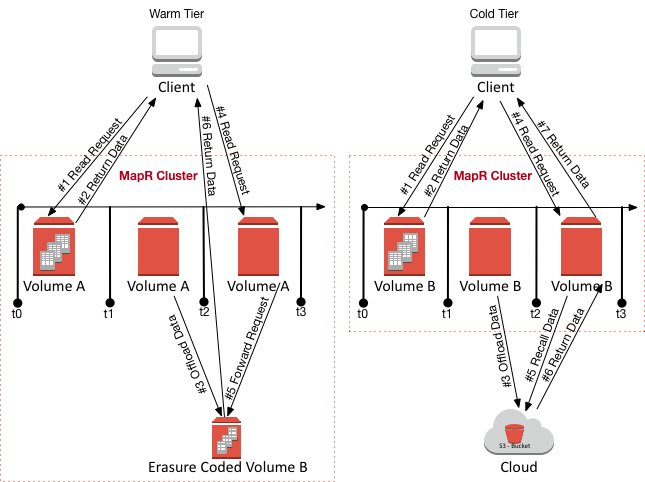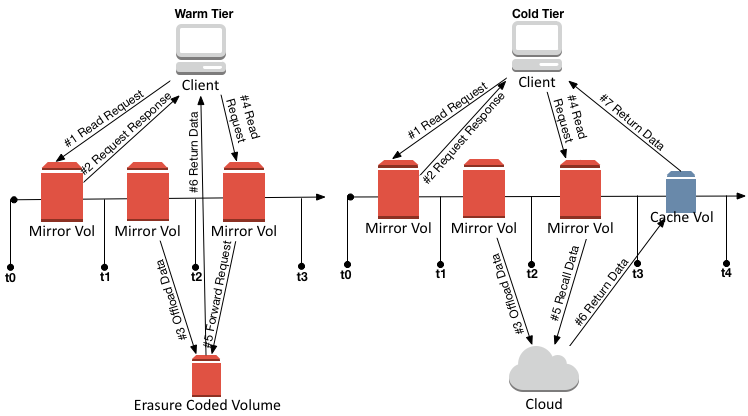Data Reads, Writes, and Recalls
Provides a synopsis of how data is read and written to a warm or cold tier.
Once offloaded to the storage tier, data is considered to be warm or cold on the storage tier, but the data can still be accessed (read, written, and recalled).
Read of Tiered Data
Depending on whether the standard volume data is outside the MapR cluster and in the cloud (cold tiering) or on the MapR cluster (warm tiering), MapR processes the request to read standard volume data and mirror volume data.
- Warm Tier
-
When a client attempts to read, the read request is first sent to the front-end volume and if the data exists in the front-end volume, the data is returned from the front-end volume. If data is not in the front-end volume, the data is returned from the erasure coded volume.
- Cold Tier
-
When a client attempts to read, the read request is first sent to the volume on the MapR cluster and if the data exists in the volume on the cluster, the data is returned from the volume. On the other hand, if the data was offloaded, the MAST Gateway recalls the data from the cold-tier to process the read request. See Recall of Tiered Data for more information on recalled data.
- Volume A, the MAST Gateway forwards the request to the back-end erasure-coded volume (#5) from where data is returned (#6) to the client.
- Volume B, the MAST Gateway recalls the data (#5 and #6) from the cloud to the volume on the MapRcluster, from where data is returned (#7) to the client.

- Warm Tier
-
When a client attempts to read, the read request is first sent to the front-end volume and if the data exists in the front-end mirror volume, the data is returned from the front-end volume. If data is not in the front-end volume, the data is returned from the erasure coded volume.
- Cold Tier
-
When a client attempts to read, the read request is first sent to the volume on the MapR cluster and if the data exists in the volume on the cluster, the data is returned from the volume. On the other hand, if the data was offloaded, the MAST Gateway recalls or fetches a copy of the data (from the tier) into an associated cache-volume, from where data is returned to the client. See Recall of Tiered Data for more information on recalled data.
- Warm tier, data is returned from the back end erasure-coded volume (#5).
- Cold tier, data is recalled in the associated cache-volume (#5 and #6), from where data is returned to the client (#7).

The cache-volume named mapr.internal.cv.<volume-name>_<id> is
created when the tiering-enabled mirror volume is created. Although it may not hold
any data initially, a copy of the tiered data is fetched into the cache-volume
whenever there is a read of the cold-tiered mirror volume data or explicit recall of
(cold or warm) tiered mirror volume data. You can use the volume info command on the
tiering-enabled mirror volume to get the offload and recall statistics, which are from
the cache-volume, for the mirror volume.
The cache-volume has the same replication factor as the mirror volume (at the time of volume creation); changes to the mirror volume replication factor do not trigger a change to the replication factor of the associated cache-volume.
If the tiering-enabled mirror volume is deleted, the cache-volume is also deleted. If the tiering-enabled mirror volume is promoted to a read-write volume, the associated cache-volume is deleted.
Write on Tiered Data
When writes happen, if the write is:
- An append, new data is offloaded when the data meets the criteria in the rule (associated with the volume) for offload.
- A change to existing data (overwrite), the data is recalled to the MapR filesystem to allow the write to succeed and then offloaded when the data meets the criteria in the rule (associated with the volume) for offload. See Recall of Tiered Data for more information on recalled data.
Recall of Tiered Data
Offloaded data is automatically recalled when a client performs a read or overwrite on the data in the cold-tier, or when a client performs an overwrite on the data in the warm-tier. The MAST Gateway fetches a copy of the data to allow the operations to succeed. You can also manually trigger a recall of:
- All volume data using the
maprclicommand or REST API.See Recalling a Volume to MapR File System for more information.
- File using the
hadoopcommand,maprclicommand, REST API, (loopbacknfs or FUSE-based) POSIX client, or the NFS client.See Recalling a File to MapR File System Using the CLI and REST API and Running Tiering Commands when maprcli and hadoop Commands are not Available for more information.
- Offloaded again based on the rules if there are changes to the data.
- Purged when the compactor runs if there are no changes to the data.
For a cold tiering volume, explicitly recall the volume before running any analytics jobs.
For mirror volumes, when you recall tiered data, data from the tier is recalled into an associated cache-volume, which is created at the time of the creation of the tiering-enabled mirror volume. For all explicit recall of warm-tiered data and explicit and automatic recalls of cold-tiered data, the MAST Gateway recalls data into the associated cache-volume. The data in the cache-volume is "hot" in the cluster, or available for reads, for the duration of the expiry-period. The recalled data is purged by the compactor when the expiration time that is set at the volume level is reached or has passed.
If the recall fails, CLDB retries the operation after some time. See Retrying Failed Operation for more information.